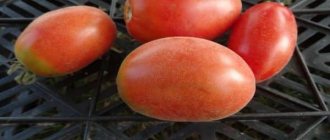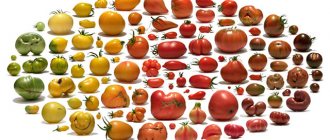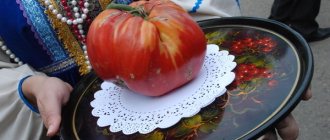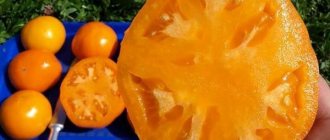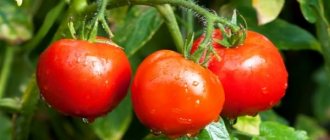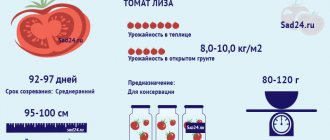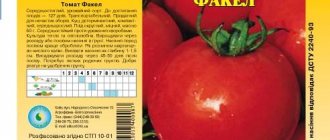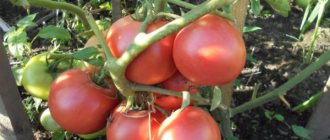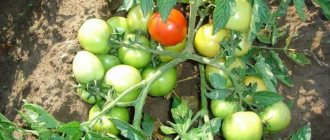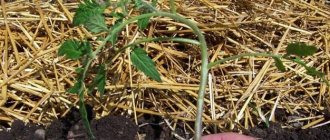The tomato with the unusual name King Penguin f1 is a tasty hybrid with large, fleshy fruits. It is convenient to grow it for sale due to the density of the tomatoes, but it is also suitable for cultivation in summer cottages, since the bushes are not capricious, and the fruits are quite tasty in fresh and processed form.
| Height | Landing location | Ripening time | Fruit color | Fruit size | Origin | Fruit shape |
| Medium height | Greenhouse, Open ground | Mid-season | Reds | Large | Hybrid | Plum-shaped or oval |
Description of the variety
"King Penguin" is a hybrid tomato variety. The determinate bush grows up to 120 cm in height. About 12 clusters are formed on a standard plant. The leaves are medium sized, dark green. A simple inflorescence is formed every two leaves.
REFERENCE: Tomatoes ripen 110-120 days after germination.
Description of fruits:
- Round, elongated shape;
- Large and fleshy tomatoes;
- Average weight is about 200 grams;
- Rich red color of ripe tomatoes;
- Average number of seeds;
- 3-4 seed chambers;
- Increased dry matter content;
- Resistance to cracking;
- Juicy pulp;
- Excellent sweet taste;
- Long shelf life.
Description of the King Penguin tomato and growing a hybrid in open ground
The King Penguin tomato is one of the hybrids that specialists from several countries have worked on to breed. This variety is intended for growing in open ground in warm countries. In Russia, it can be grown in film greenhouses and hotbeds.
Tomatoes of this variety ripen almost simultaneously on all bushes. The tomato resists cracking well, so it can be transported over long distances. The fruits can be stored for a long time.
They are used fresh, processed into tomato paste, and preserved for the winter with whole berries.
Some information about the plant and its fruits
The characteristics and description of the King Penguin F1 variety are as follows:
- The vegetative period from the appearance of the first shoots to the harvest lasts no more than 118 days.
- This variety has bushes up to 120-150 cm high. From each of them you can get a truly royal harvest, since each bush produces up to 12 clusters that bear fruit.
- The leaves on the plant are medium in size and colored in dark tones of green. Inflorescences appear every 2 leaves.
- Tomatoes of this type are resistant to various diseases of nightshade crops.
- The fruits of the hybrid are slightly elongated in length. Their weight ranges from 180 to 200 g. The pulp has sufficient density. Unripe berries are colored green, which changes in the area of the stalk. Ripe fruits are colored bright red.
- There are 3 or 4 seed chambers inside the berries, but there are few seeds themselves.
Reviews from gardeners show that the King Penguin is the real king of garden beds, as it has virtually no drawbacks. The plant is resistant to many garden pests.
The yield of the variety ranges from 3 to 5 kg of berries from each bush. Due to the large weight of the fruits (their weight reaches 400 g for experienced gardeners), the plants have to be tied to stakes. Otherwise, the tomato branches will break.
Most farmers form a bush of 2-3 stems.
Despite its resistance to diseases, the hybrid is often affected by late blight. To prevent the disease, it is recommended to treat the tomato before the flowers appear on the bushes with Oxychom.
To eliminate a fungal infection, water the hybrid with Bordeaux mixture.
How to grow this variety in your personal yard?
Seedlings are grown from seeds pre-treated with hydrogen peroxide or potassium permanganate. They are sown in boxes with special soil for tomatoes in March or April. After the emergence of seedlings, they are distributed into separate containers. Water the seedlings with warm water and feed them with manure or peat. Fertilizers containing nitrogen can also be used.
When the sprouts have 6-7 leaves, they can be transferred to open ground. It is recommended to maintain a distance of 0.4 m between bushes. The hybrid planting pattern is 0.5x0.4 m. In this case, the soil in the beds should warm up to +24...+26°C.
Watering is done once a week, but the volume of liquid used should be large. Irrigation is increased during the flowering period of plants or when the first fruits appear.
Tomato bushes should be tied up with wide ribbons to avoid damaging the stems. This operation is not necessary, but if a large number of fruits form on the bushes, it is better to place strong supports under the tomato branches.
To combat insects that parasitize the roots of plants, you need to mulch the soil. This measure will also protect the bushes from fungal infections.
It is recommended to fertilize with complex fertilizers every 8-10 days. This frequency of introducing the substances necessary for the plant into the soil allows you to obtain maximum yield. If complex mixtures are not available, organic fertilizers containing potassium, nitrogen and phosphorus are used instead.
Although the King Penguin can resist a variety of garden pests, the farmer must keep a close eye on the appearance of insects on plant leaves. At the first danger from pests, it is recommended to use copper sulfate or chemicals against them (but not during the fruiting period).
If the fruits have already appeared, then a soap solution is used to destroy the insects or they are collected by hand and then destroyed outside the site. To eliminate slugs that appear, you need to treat the ground under the bushes with wood ash.
Growing tomatoes
The hybrid is grown by seedlings.
How to prepare seeds?
Planting material for seedlings must be dense and not infected with fungus. Selected seeds are soaked for several hours in a slightly pink solution of potassium permanganate. Special growth stimulants will help improve seed germination.
Sowing seed material
Seeds for seedlings are planted in late March or early April. Planting material is placed in shallow containers filled with nutritious and light soil. The plantings are sprayed with warm water from a spray bottle and covered with plastic wrap. Containers with planted seeds should be kept in a room with a temperature of at least 23-25 degrees Celsius.
After the sprouts appear, the film is removed and the container is placed in a well-lit place.
When two true leaves appear, the seedlings are picked into separate pots.
Seedlings should be watered as the soil dries. Before planting, the seedlings are taken out into fresh air for hardening, first for several hours, and then for the whole day.
Rules for planting seedlings
Plants are planted in open ground after the formation of 5-6 leaves, in the first half of June. The optimal soil temperature for planting is 26-30°C. Holes are formed in the beds, at the bottom of which a tablespoon of sifted wood ash or superphosphate is placed.
The distance between bushes should be at least 40 cm.
Tomato variety "Royal Penguin": photo, video, reviews, description, characteristics, yield
Raspberry Penguin helps to extend the enjoyment of the taste of raspberries until autumn. No gardener will refuse to show off delicious large raspberries in October. In addition, the variety is very decorative and can decorate any corner of the garden.
The Penguin raspberry variety was bred under the guidance of the outstanding Russian breeder-researcher Ivan Vasilyevich Kazakov.
The scientist is a trendsetter in the development of a new direction in our country - the cultivation of remontant raspberries.
Kazakov created high-yielding varieties that are resistant to adverse factors and intended for mechanized harvesting. The Penguin variety was obtained in 2006. It was included in the State Register of the Russian Federation in 2009.
Raspberry Penguin belongs to the remontant varieties of early ripening. It is a bush with straight, standard-type shoots. The height of the Penguin raspberry stems, judging by the description, reaches 1.3-1.5 m, the number of which is limited to 4-6 pieces.
Annual shoots are green, with a significant waxy coating. Two-year-old shoots are light brown, strong, with short internodes.
At each node a short but strong berry cluster is formed, on which 8-10 berries are placed. The shoots have short, slightly curved downward spines of crimson or green color.
They are distributed unevenly along the stem, with more thorns at the bottom and fewer at the top.
The leaves are ordinary, green, slightly wrinkled, and have fibers. There are small teeth along the edges of the leaves. The side branches with ovaries are covered with a light waxy coating. The flowers are medium-sized and white. The berries are large, crimson, conical in shape with a rounded top. The average fruit weight is 4.2 g, maximum weight is 6.5 g.
Berries begin to ripen in the southern regions in mid-July, in the northern regions - in early or mid-August. When grown in a two-year cycle, Penguin raspberries produce the first harvest in late spring, and the second in late summer.
With this method of cultivation, the yield and size of the berries are reduced, and full ripening of the berries is possible only in the southern regions.
King Penguin raspberry is a tall variety of the remontant variety Penguin. The shoots of the plant are straight and grow up to 1.8 m in height.
Thanks to the strength of the stems, the plant can withstand the load of the harvest without being tied to a support. The King Penguin variety produces little growth.
According to gardeners, the berries of remontant King Penguin raspberries are distinguished by their round shape, large size, weight (8-10 g) and bright red color.
Another variety of Penguin raspberries, but with yellow berries, is the Yellow Penguin variety. The plant is a standard type, compact, stems up to 1.5 m long. It forms only 3-4 strong shoots. The productive variety Yellow Penguin has large berries, weighing 7-8 g, dense, round in shape.
To choose a suitable variety for growing on your personal plot, it is worth taking into account the characteristics of raspberries. The main criteria for evaluating a particular variety are frost resistance, yield, resistance to adverse factors, and area of application.
READ MORE: Diuretic herbs for the kidneys, list of recipes, decoctions, tablets
Raspberries of the Penguin variety are frost-resistant. In late autumn, raspberry stems are completely cut off at the root. This allows the variety to be grown in the northern regions. When grown for two years, the stems of the Penguin and Yellow Penguin varieties can withstand frosts down to - 25 ° C, and the Royal Penguin variety - up to - 33 ° C.
The average yield of the Penguin variety is 3.5 kg per bush. The fruits hold their shape well, withstand transportation over long distances, are not prone to shedding, and do not wither in the sun.
Fruiting is extended (August-October), harvesting is carried out after 1-2 days. The taste of the berries is sweet and sour, without a pronounced aroma, with a sugar content of 3.1%.
The tasting assessment of taste, determined by specialists, is 3.7 points.
The average yield of the Yellow Penguin variety per plant is 5-6 kg. The variety is early ripening - the first harvest appears at the end of July. Ripe Yellow Penguin berries retain their shape during harvesting and transportation. When growing Yellow Penguin, even in the shade, the fruits have a dessert taste.
Remontant raspberries of the Penguin variety are consumed both fresh and frozen. Or used to make preserves, jellies, jams, marmalade, juices and compotes.
Dried fruits and leaves are used as a diaphoretic and antipyretic for colds and flu. The leaves are used as tea. Before this, they are fermented and dried.
Infusions and decoctions are also used in folk medicine to treat various diseases.
The Penguin variety, when cultivated as an annual crop, is not attacked by pests and does not get sick. This is due to the fact that in the fall the shoots are cut off at the root and burned. Diseases and pests simply have nowhere to overwinter and reproduce.
The Penguin variety has many advantages, which is why it is in demand in amateur gardening.
Advantages:
- high productivity;
- large fruit;
- decorativeness;
- high keeping quality of berries;
- frost resistance up to - 25 ° C;
- resistance to diseases and pests.
Flaws:
- thorns on shoots;
- mediocre taste;
- demands on soil and watering.
Landing Features
The peculiarities of planting Penguin raspberries include its demands on soil composition and lighting. The variety is comfortable growing in soil with weak or neutral acidity.
In soil with high acidity, fertilizers are ineffective. An indicator that the soil is acidic is the presence of plants such as horsetail, sorrel, woodlice, and bindweed in the area.
You can deoxidize the soil by adding limestone or dolomite flour.
Before planting raspberries, it is recommended to sow green manure on the site and then embed it in the ground. Also, rotted manure and humus are added to the soil under the raspberry tree, combined with the application of potassium and phosphorus fertilizers. Such events will provide raspberries with food for 3-4 years.
Advice! No less important is the location of raspberry plantings in an area open to light, which will be warmed by the sun throughout the day.
In the sun, the berries ripen earlier and become sweeter.
Penguin raspberries are not suitable for areas where rainwater stagnates or where groundwater is located high. With excess water, raspberry roots are susceptible to rotting.
Recommended timing
Raspberries can be planted in spring and autumn. Autumn planting allows you to get a harvest the following year. Preparations for it should begin in the summer. The planting area should be dug up with fertilizers. Favorable time for planting is September-October.
The cuttings will have time to root in order to produce young shoots as early as possible in the spring. This is important for remontant raspberries, since berries will set and ripen on these shoots. When planting in spring, the time for fruiting comes later, as the seedling needs time to adapt.
But over the summer, the young plants will get stronger and survive the winter safely.
Experts recommend planting the remontant Penguin raspberry on the south side of residential buildings, fences, and outbuildings. The buildings protect the plantings from the northern winds. In these places, the snow melts earlier and the earth warms up faster. The sooner the snow melts from the plantings and the shoots begin to grow, the sooner the first berries will appear.
The Penguin variety does not like waterlogging. Raspberries are not placed in lowlands where moisture is retained. To drain water, drainage ditches should be dug around the perimeter of the planting.
Advice! Raspberries should not be planted after potatoes, tomatoes, or eggplants, as they share diseases with them.
It is safer to purchase raspberry seedlings in specialized stores and nurseries. You should choose high-quality specimens with well-developed roots and buds at the base of the shoots (at least 3).
Landing algorithm
Planting technology:
- Dig holes 45x50 cm in size and 40 cm deep, maintaining 70 cm between them, and 1.5-2 m between rows. The removed soil should be thoroughly mixed with fertilizer, after which half the volume should be placed at the bottom of the hole.
- Soak the seedlings in the biostimulator for 2-3 hours.
- Place each plant in a hole, straighten the roots, and cover with soil.
- Compact the soil and water generously.
- The seedling should be trimmed, leaving no more than 6 cm above the ground. Mulch around the plant with sawdust, straw or hay.
Aftercare
Caring for raspberries affects the quality of the berries and involves watering and fertilizing.
Raspberries of the Penguin variety are intended for growing as an annual crop. This makes caring for raspberries easier. In October, all shoots are cut off at the root without stumps. In the spring, in order to encourage the sprouts to awaken, the area with raspberries must be cleared of snow and covered with film. The tops of young shoots do not need to be trimmed.
Raspberries need moderate systematic watering with settled water in the morning or evening. After moistening, the soil is loosened and weeds are removed. Mulching the soil around the bushes will help reduce the number of waterings and retain moisture in the ground.
Remontant raspberries of the Penguin variety require periodic feeding.
| Fertilizing time | Feeding method | Fertilizers/proportions per 1 sq. m |
| Early spring | Prikornevoy | Universal fertilizers containing nitrogen, potassium, phosphorus. Ammonium nitrate (15-20 g per 10 liters of water). An alternative is humus, bird droppings, urea. |
| Before flowering | Prikornevoy | Double superphosphate (3 tbsp) and potassium sulfate (2 tbsp) are dissolved in 10 liters of water. Infusions of nettle and ash. |
| Late autumn | Prikornevoy | Humus or compost. Adding wood ash. |
In order for remontant Penguin raspberries to survive the winter well, it is necessary to water the plantings abundantly before the first hard frost. If the shoots are cut at the root, then the roots should be covered with peat, humus or straw.
Annual shoots left to obtain a double harvest should be bent to the ground and covered. It is convenient to tie the stems to a wire stretched at a height of 35-40 cm from the ground. Then cover the bushes with covering material. In winter, you need to ensure that the raspberry tree is always covered with a layer of snow of at least 0.5 m. In winters with little snow, the raspberry tree is covered with snow manually.
Reproduction methods
Bush care
Basic steps for caring for King Penguin hybrid plants:
- Moderate watering in the evening with warm and settled water;
- Frequent loosening of the soil in the beds;
- Weeding;
- Fertilizing with organic fertilizers and nutritional mineral complexes.
During flowering and ovary formation, plants need frequent watering. The bush is formed into one stem; pinching is necessary before fruit formation.
Branches with large and heavy tomatoes are tied to supports or pegs.
IMPORTANT: Bushes should be tied up using wide ribbons - this will prevent them from being damaged.
Growing and care
Water the tomato in the evening with heated water at the root. Watering should be regular.
The soil in the beds is loosened, weeds are weeded, and bushes are hilled. They are led into 2-3 stems and the branches are secured to the supports with wide cotton ribbons.
Feed every 2-3 weeks with weak solutions of mineral fertilizers, as well as wood ash. During the early stages of growth, diluted manure can be applied. Optimal timing for fertilizing:
- At the seedling stage, a special seedling fertilizer or urea solution is applied.
- 10-14 days after the bushes take root in the garden bed, they are watered at the root with a 1:10 solution of manure.
- At the beginning of budding, you can add mineral fertilizer or a solution of wood ash (0.5 kg of ash is dissolved or boiled in a bucket of water).
- During the ripening period, mineral fertilizers are applied twice.
If the tomatoes ripen slowly, the process will speed up after spraying the bushes with a solution of boric acid.
Diseases and pests
The King Penguin hybrid is resistant to dangerous diseases that affect crops of the nightshade family. However, tomatoes can be affected by late blight. For preventive purposes, plantings are treated with special preparations.
To avoid the appearance of fungi on the site, plants are treated with Bordeaux mixture before fruit formation begins.
Tomatoes can be threatened by the following pests:
- Aphid;
- Spider mite;
- Thrips;
- Colorado beetle;
- Slugs.
Proven folk methods or special insecticides will help you get rid of insects and slugs.
Description and characteristics of the variety
Hybrid King Penguin f1 from Gardens of Russia is the result of the work of an international team of breeders. In 2004, it was included in the State Register of the Russian Federation. It is recommended to plant it in warm areas in open ground, and in the middle zone and to the north - in greenhouses or shelters.
Characteristics of the bushes: standard, determinate, about 1.2 m in height. The fruits develop in clusters, of which there are about 12 on each bush. The leaves are ordinary tomato leaves. The ripening of the crop occurs after 110-120 days from the moment of germination of the plantings.
Description of the fruits: large, leveled, weighing 200 g, but can reach 400 g. Their shape resembles an elongated oval. Inside there are 3-4 chambers with seeds. The flesh and skin are red. The taste is excellent, with honey sweetness and light sourness.
Tomatoes are not prone to cracking and tolerate transportation and storage well.
